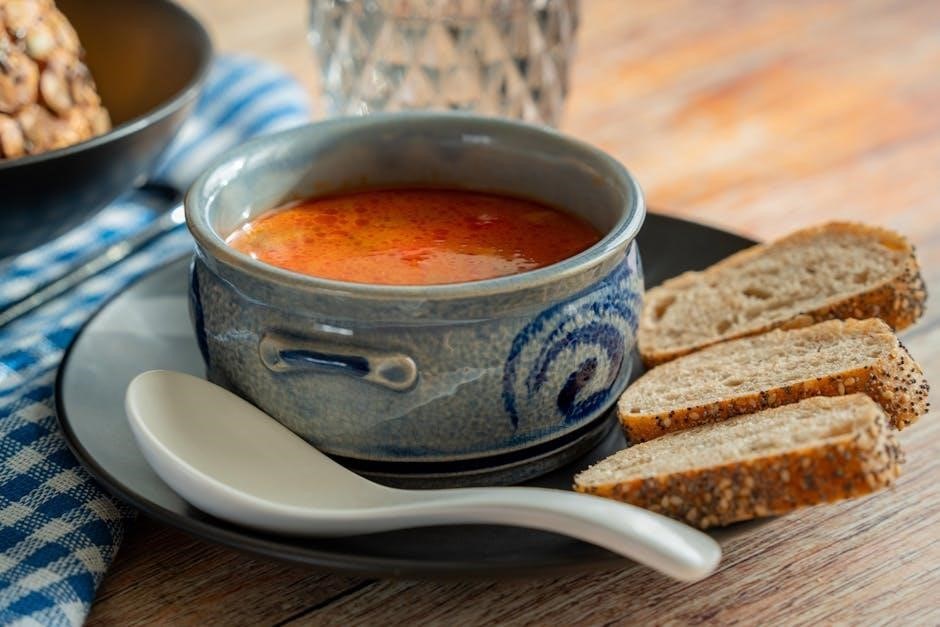Bread maker recipe books provide step-by-step guides for creating delicious bread at home․ They include recipes for classic, whole wheat, and specialized breads, offering versatility and ease․
1․1 Overview of Bread Maker Functionality
A bread maker automates the bread-making process, handling mixing, rising, and baking․ It allows users to customize settings like crust color and loaf size, with some models featuring delayed timers and specialized programs for gluten-free or sourdough bread․ The machine ensures precise temperature control and even baking, while advanced models include fruit and nut dispensers for added convenience․ By following the recipe book’s guidelines, users can effortlessly create a variety of breads, from classic white to whole wheat, with minimal effort and consistent results․
1․2 Benefits of Using a Bread Maker Recipe Book
A bread maker recipe book simplifies the bread-making process, offering pre-tested recipes for consistent results․ It provides clear step-by-step instructions, ensuring success for both novices and experienced bakers․ These books often include a variety of recipes, catering to dietary preferences like gluten-free or whole wheat․ They also offer tips on ingredient measurements, yeast activation, and troubleshooting common issues; By following these guides, users can experiment with new flavors and techniques, making bread making both enjoyable and rewarding․ Additionally, recipe books save time and reduce trial-and-error, enhancing the overall bread-making experience․
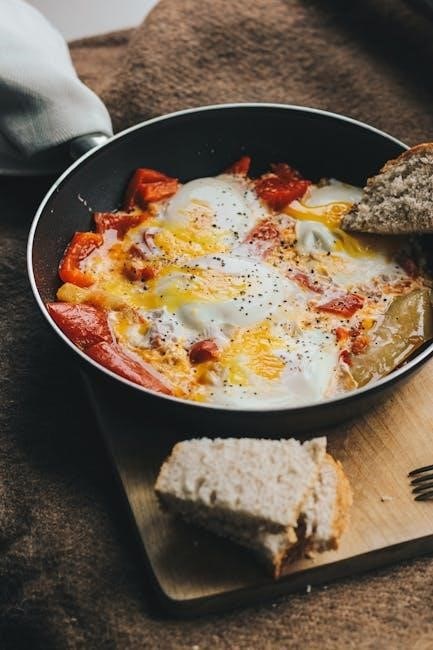
Essential Components of a Bread Maker
A bread maker consists of a bread pan, kneader, control panel, and heating element․ These components work together to automate mixing, rising, and baking processes․
2․1 Understanding the Bread Maker Parts
The bread maker includes a bread pan with a handle for easy removal, a kneader for mixing dough, and a control panel for selecting settings․ The heating element ensures even baking, while the lid allows monitoring․ Some models feature a fruit and nut dispenser for added ingredients; Proper care, like cleaning the pan and kneader, is essential for longevity․ These parts work together to simplify bread making, ensuring consistent results with minimal effort․
2․2 Basic Ingredients for Bread Making
The fundamental ingredients for bread making include high-quality flour, water, yeast, salt, and sometimes sugar or fats like butter or oil․ Flour provides structure, while yeast ensures rise․ Salt enhances flavor and controls yeast activity․ Water hydrates the dough, and sugar feeds yeast for fermentation․ Optional ingredients like milk or nuts can add texture and variety․ Using fresh, precise measurements ensures optimal results․ These basics form the foundation for all bread recipes, whether simple or complex, in your bread maker․

Basic Bread Recipes for Beginners
Perfect for first-time users, these simple recipes include classic white bread and whole wheat options․ Step-by-step instructions ensure easy bread making with minimal ingredients and effort required․
3․1 Classic White Bread Recipe
The classic white bread recipe is a timeless favorite, offering a soft and fluffy texture with a golden crust․ It typically requires basic ingredients such as water, flour, yeast, salt, sugar, and melted butter or oil․ The bread maker simplifies the process by handling mixing, rising, and baking․ Simply add ingredients in the specified order, select the appropriate program, and let the machine work its magic․ Perfect for sandwiches or toast, this recipe is a great starting point for beginners․
3․2 Whole Wheat Bread Recipe
The whole wheat bread recipe offers a healthier alternative with a nuttier flavor and denser texture․ It uses whole wheat flour, water, yeast, salt, sugar, and oil․ Some recipes may include additional ingredients like nuts or seeds for extra flavor and nutrition․ Simply add the ingredients to the bread pan in the recommended order, select the whole wheat program, and let the machine handle the rest․ This recipe is perfect for those seeking a more wholesome bread option without compromising on taste or convenience․

Specialized Bread Recipes
Explore diverse recipes like gluten-free, sourdough, and sweet breads․ These specialized options cater to various dietary needs and preferences, offering unique flavors and textures for every palate․
4․1 Gluten-Free Bread Options
Gluten-free bread options are perfect for those with dietary restrictions․ Recipes often use rice flour, potato starch, and xanthan gum for structure․ The bread maker simplifies the process, ensuring even mixing․ Cycle 3 is ideal for gluten-free recipes, offering tailored settings․ Follow ingredient ratios carefully to achieve the best texture․ Experiment with flavors like olive oil or herbs for variety․ These recipes make enjoying fresh, homemade gluten-free bread effortless and delicious, catering to all tastes and preferences․
4․2 Sourdough Bread Recipes
Sourdough bread recipes are a delightful option for bread enthusiasts, relying on natural starters instead of commercial yeast․ Bread makers simplify the process, handling mixing and rising with ease․ Use a room-temperature starter for optimal rise and adjust cycles as needed․ Crust settings allow for customization, from light to dark․ Perfect for enthusiasts, sourdough recipes in PDF books offer convenience and flavor, ensuring homemade bread perfection․
4․3 Sweet Bread Variations
Sweet bread variations add a delightful twist to traditional recipes, offering fruity and nutty flavors․ Ingredients like raisins, cranberries, or chocolate chips enhance the taste, while spices like cinnamon provide warmth․ Bread makers simplify the process, handling mixing and baking effortlessly․ Try recipes like raisin bread or sweet spiced bread, following the ingredient order and settings outlined in PDF guides․ Adjust crust color for a golden finish and experiment with add-ins for personalized treats, ensuring a sweet and satisfying homemade loaf every time․
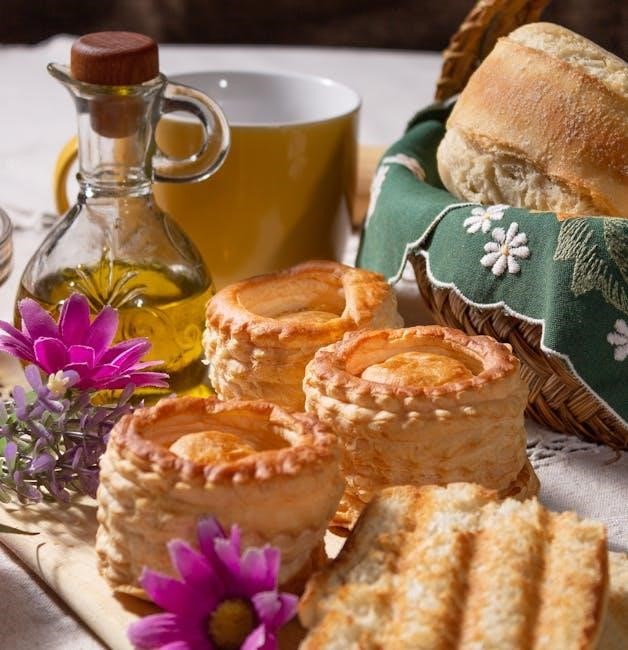
Tips for Perfect Bread Making
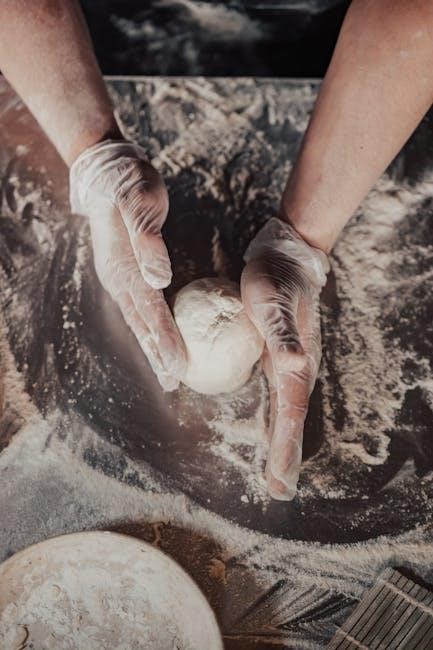
Ensure accurate measurements and proper yeast activation․ Maintain ingredients at room temperature for optimal results․ Regularly clean the bread pan and kneader for hygienic baking․
5․1 Common Mistakes to Avoid
Avoid overmixing dough, as it can lead to dense bread․ Ensure yeast is measured and activated correctly․ Never add ingredients out of order or skip preheating․ Clean the bread pan and kneader immediately after use to prevent residue buildup․ Regularly check and replace worn-out parts․ Avoid using hot water, as it can kill yeast․ Don’t open the lid during the baking cycle, as it disrupts even cooking․ Properly store yeast to maintain its effectiveness․ Follow the recipe’s exact measurements for best results․
5․2 Adjusting Recipes for Different Loaf Sizes
When adjusting recipes for different loaf sizes, maintain ingredient ratios․ For smaller loaves, reduce quantities proportionally․ Increase yeast slightly for larger loaves․ Ensure liquid levels match flour amounts to maintain dough consistency․ Adjust baking time based on loaf size, with smaller loaves requiring less time․ Use crust color settings wisely to prevent over-browning․ Always measure ingredients accurately to avoid imbalances․ Refer to your bread maker’s manual for specific guidance on scaling recipes effectively․
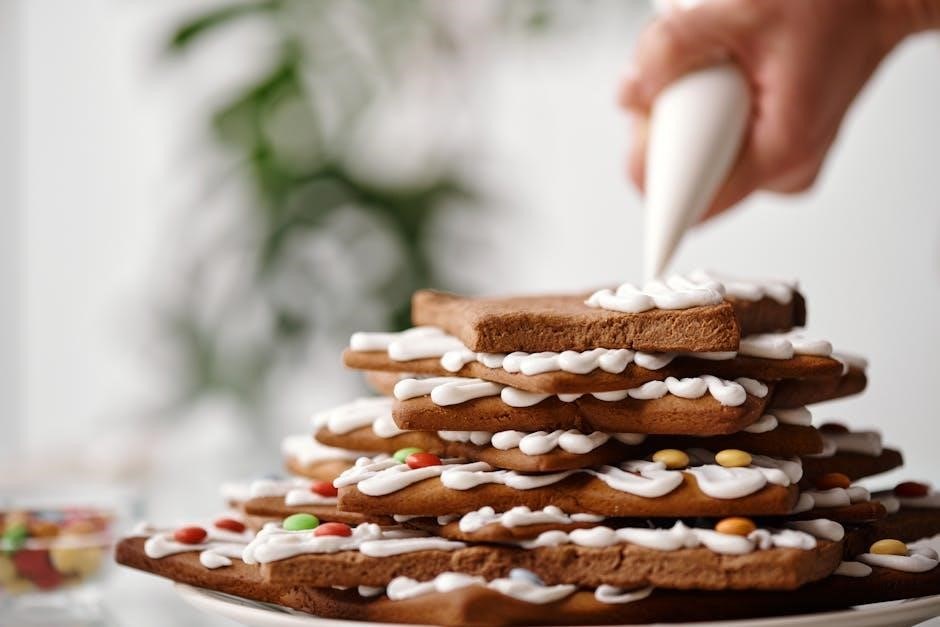
Advanced Recipes for Experienced Users
Explore advanced recipes like international breads, sourdough, and artisan dough variations․ These recipes cater to experienced users, offering creative and diverse bread-making challenges with precise instructions․
6․1 International Bread Recipes
Explore diverse international bread recipes, from French baguette to Italian ciabatta, German rye, and Middle Eastern pita․ These recipes offer authentic flavors and textures, perfect for experienced users․ The bread maker simplifies the process of creating these global specialties, ensuring precise mixing and baking․ Recipes include detailed ingredient lists and instructions for achieving traditional results․ Try Mexican bolillo or Greek village bread for a unique touch․ Adjustments for loaf sizes and crust preferences are also provided, making it easy to customize your international creations․
6․2 Bread Maker Dough Recipes
Bread maker dough recipes expand your culinary possibilities, offering versatile bases for pizza, rolls, and pasta․ These recipes provide detailed instructions for perfect dough texture and rise․ From classic white to whole wheat and herb-infused variations, the bread maker ensures consistent results․ Customize dough for specific needs, such as gluten-free or sourdough․ Tips on ingredient order, yeast activation, and machine settings are included for optimal outcomes․ Perfect for both beginners and advanced users, these dough recipes unlock a world of homemade creations with ease and precision․

Maintenance and Care of Your Bread Maker
Regularly clean the bread pan and kneader after use․ Soak parts in warm water for easy cleaning․ Avoid harsh chemicals and abrasive cleaners to maintain longevity and performance․
7․1 Cleaning the Bread Pan and Kneader
Regular cleaning of the bread pan and kneader is essential for maintaining hygiene and functionality․ After use, unplug the machine and let the pan cool slightly․ Remove the bread pan and soak it in warm water for 10 minutes to loosen dough residue․ Use a soft sponge or brush to clean, avoiding abrasive cleaners or bleach․ Dry thoroughly to prevent rust․ For stubborn stains, mix baking soda and water to create a paste, apply, and rinse․ Clean the kneader separately and store both parts properly after drying․
7․2 Troubleshooting Common Issues
Common issues with bread makers include uneven baking, sticky dough, or machine malfunctions․ Check if ingredients are measured correctly and at the right temperature․ Ensure the yeast is active and not expired․ If the bread isn’t baked evenly, verify the machine’s heating elements are working․ For sticky dough, adjust flour or liquid ratios․ Refer to the user manual for specific error codes and solutions․ Regular maintenance and proper cleaning can prevent many issues, ensuring consistent results and extending the machine’s lifespan․ Always unplug before troubleshooting electrical components․

Using Yeast in Bread Making
Yeast is essential for bread rise․ Use bread machine yeast or active dry yeast, ensuring proper activation with warm water․ Measure accurately for best results․
8․1 Types of Yeast for Bread Makers
Active dry yeast and bread machine yeast are ideal for bread makers․ Active dry yeast requires activation, while bread machine yeast dissolves quickly in warm water․ Both ensure a light, airy texture․ Some recipes also use instant yeast for faster rising․ Always follow package instructions for proper measurement and activation to achieve the best results in your bread maker recipes․
8․2 Measuring and Activating Yeast
Accurate yeast measurement is crucial for bread making․ Use a digital scale or measuring spoons for precise amounts․ Activate yeast by mixing it with warm water (80-90°F) in a small bowl․ Let it sit for 5-10 minutes until frothy and bubbly, indicating it’s active․ For bread machine yeast, follow package instructions for proper activation․ Always ensure the water is not too hot, as it can kill the yeast․ Proper activation guarantees a light, airy texture in your bread․
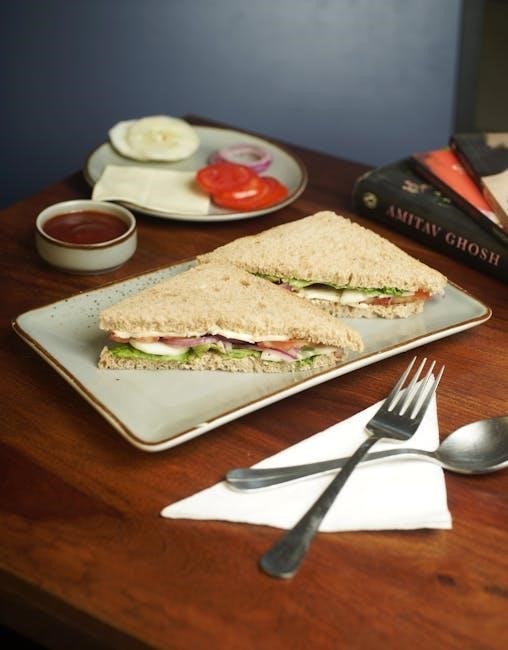
Digital Resources for Bread Maker Recipes
Explore a variety of digital resources, including PDF recipe books for bread makers like Panasonic and Cuisinart․ Find step-by-step guides and troubleshooting tips online․
9․1 Downloading PDF Recipe Books
Downloading PDF recipe books for bread makers offers convenient access to diverse recipes․ These books, such as the “Breadmaker Recipe Book Final” and Panasonic SD-ZP2000 guide, provide detailed instructions for various bread types, including white, whole wheat, and sourdough․ They often include step-by-step guides, ingredient lists, and troubleshooting tips․ Users can easily find and download these resources online, ensuring they have a wide range of recipes at their fingertips to experiment with different flavors and loaf sizes․
9․2 Online Communities for Bread Maker Enthusiasts
Online communities for bread maker enthusiasts offer a wealth of knowledge and support․ These platforms allow users to share recipes, tips, and experiences, fostering a collaborative environment․ Many forums and social media groups are dedicated to bread making, where members can discuss techniques, troubleshoot issues, and discover new ideas․ Additionally, these communities often provide access to downloadable PDF recipe books and expert advice, making them invaluable resources for both beginners and experienced bakers looking to refine their skills and explore creative recipes․
Thank you for exploring our comprehensive guide to bread maker recipe books․ May your journey with bread making be joyful, creative, and endlessly rewarding․ Happy baking!
10․1 Final Tips for Mastering Bread Making
Consistency is key—use quality ingredients and precise measurements․ Monitor yeast activation to ensure proper rise․ Experiment with flavors and dough cycles for unique results․ Regularly clean and maintain your bread maker for optimal performance․ Practice makes perfect, so don’t be discouraged by early mishaps․ Explore diverse recipes and techniques to broaden your bread-making skills․ Happy baking!
10․2 Encouragement to Experiment and Share Recipes
Don’t hesitate to explore beyond basic recipes—try new ingredients and flavors to create unique breads․ Share your creations with friends and family, and join online communities to exchange ideas․ Experimenting with different yeast types, loaf sizes, and crust settings can lead to exciting discoveries․ Inspire others by posting your recipes online or in bread-making forums․ The joy of bread making lies in its endless possibilities, so embrace creativity and share your passion with others!
